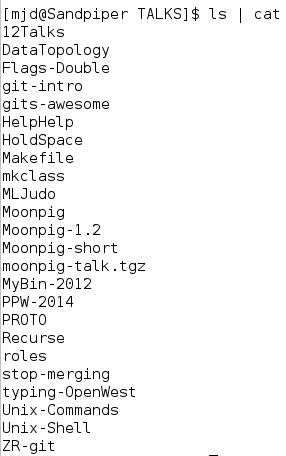Mark Dominus (陶敏修)
mjd@pobox.com

Archive:
| 2025: | JFMAMJ |
| JAS | |
| 2024: | JFMAMJ |
| JASOND | |
| 2023: | JFMAMJ |
| JASOND | |
| 2022: | JFMAMJ |
| JASOND | |
| 2021: | JFMAMJ |
| JASOND | |
| 2020: | JFMAMJ |
| JASOND | |
| 2019: | JFMAMJ |
| JASOND | |
| 2018: | JFMAMJ |
| JASOND | |
| 2017: | JFMAMJ |
| JASOND | |
| 2016: | JFMAMJ |
| JASOND | |
| 2015: | JFMAMJ |
| JASOND | |
| 2014: | JFMAMJ |
| JASOND | |
| 2013: | JFMAMJ |
| JASOND | |
| 2012: | JFMAMJ |
| JASOND | |
| 2011: | JFMAMJ |
| JASOND | |
| 2010: | JFMAMJ |
| JASOND | |
| 2009: | JFMAMJ |
| JASOND | |
| 2008: | JFMAMJ |
| JASOND | |
| 2007: | JFMAMJ |
| JASOND | |
| 2006: | JFMAMJ |
| JASOND | |
| 2005: | OND |
Subtopics:
| Mathematics | 245 |
| Programming | 99 |
| Language | 95 |
| Miscellaneous | 75 |
| Book | 50 |
| Tech | 49 |
| Etymology | 35 |
| Haskell | 33 |
| Oops | 30 |
| Unix | 27 |
| Cosmic Call | 25 |
| Math SE | 25 |
| Law | 22 |
| Physics | 21 |
| Perl | 17 |
| Biology | 16 |
| Brain | 15 |
| Calendar | 15 |
| Food | 15 |
Comments disabled
Tue, 21 Apr 2015
Another use for strace (isatty)
(This is a followup to an earlier article describing an interesting use of strace.)
A while back I was writing a talk about Unix internals and I wanted to
discuss how the ls command does a different display when talking to
a terminal than otherwise:
ls to a terminal

ls not to a terminal

How does ls know when it is talking to a terminal? I expect that is
uses the standard POSIX function isatty. But how does isatty find
out?
I had written down my guess. Had I been programming in C, without
isatty, I would have written something like this:
@statinfo = stat STDOUT;
if ( $statinfo[2] & 0060000 == 0020000
&& ($statinfo[6] & 0xff) == 5) { say "Terminal" }
else { say "Not a terminal" }
(This is Perl, written as if it were C.) It uses fstat (exposed in
Perl as stat) to get the mode bits ($statinfo[2]) of the inode
attached to STDOUT, and then it masks out the bits the determine if
the inode is a character device file. If so, $statinfo[6] is the
major and minor device numbers; if the major number (low byte) is
equal to the magic number 5, the device is a terminal device. On my
current computers the magic number is actually 136. Obviously this
magic number is nonportable. You may hear people claim that those bit
operations are also nonportable. I believe that claim is mistaken.
The analogous code using isatty is:
use POSIX 'isatty';
if (isatty(STDOUT)) { say "Terminal" }
else { say "Not a terminal" }
Is isatty doing what I wrote above? Or something else?
Let's use strace to find out. Here's our test script:
% perl -MPOSIX=isatty -le 'print STDERR isatty(STDOUT) ? "terminal" : "nonterminal"'
terminal
% perl -MPOSIX=isatty -le 'print STDERR isatty(STDOUT) ? "terminal" : "nonterminal"' > /dev/null
nonterminal
Now we use strace:
% strace -o /tmp/isatty perl -MPOSIX=isatty -le 'print STDERR isatty(STDOUT) ? "terminal" : "nonterminal"' > /dev/null
nonterminal
% less /tmp/isatty
We expect to see a long startup as Perl gets loaded and initialized,
then whatever isatty is doing, the write of nonterminal, and then
a short teardown, so we start searching at the end and quickly
discover, a couple of screens up:
ioctl(1, SNDCTL_TMR_TIMEBASE or TCGETS, 0x7ffea6840a58) = -1 ENOTTY (Inappropriate ioctl for device)
write(2, "nonterminal", 11) = 11
write(2, "\n", 1) = 1
My guess about fstat was totally wrong! The actual method is that
isatty makes an ioctl call; this is a device-driver-specific
command. The TCGETS parameter says what command is, in this case
“get the terminal configuration”. If you do this on a non-device, or
a non-terminal device, the call fails with the error ENOTTY. When
the ioctl call fails, you know you don't have a terminal. If you do
have a terminal, the TCGETS command has no effects, because it is a
passive read of the terminal state. Here's the successful call:
ioctl(1, SNDCTL_TMR_TIMEBASE or TCGETS, {B38400 opost isig icanon echo ...}) = 0
write(2, "terminal", 8) = 8
write(2, "\n", 1) = 1
The B38400 opost… stuff is the terminal configuration; 38400 is the baud rate.
(In the past the explanatory text for ENOTTY was the mystifying “Not
a typewriter”, even more mystifying because it tended to pop up when
you didn't expect it. Apparently Linux has revised the message to the
possibly less mystifying “Inappropriate ioctl for device”.)
(SNDCTL_TMR_TIMEBASE is mentioned because apparently someone decided
to give their SNDCTL_TMR_TIMEBASE operation, whatever that is, the
same numeric code as TCGETS, and strace isn't sure which one is
being requested. It's possible that if we figured out which device was
expecting SNDCTL_TMR_TIMEBASE, and redirected standard output to
that device, that isatty would erroneously claim that it was a
terminal.)
[ Addendum 20150415: Paul Bolle has found that the
SNDCTL_TMR_TIMEBASE pertains to the old and possibly deprecated OSS
(Open Sound System)
It is conceivable that isatty would yield the wrong answer when
pointed at the OSS /dev/dsp or /dev/audio device or similar. If
anyone is running OSS and willing to give it a try, please contact me at mjd@plover.com. ]
[ Addendum 20191201: Thanks to Hacker News user
jwilk for pointing
out that strace is
now able to distinguish TCGETS from SNDCTL_TMR_TIMEBASE. ]
[Other articles in category /Unix] permanent link


